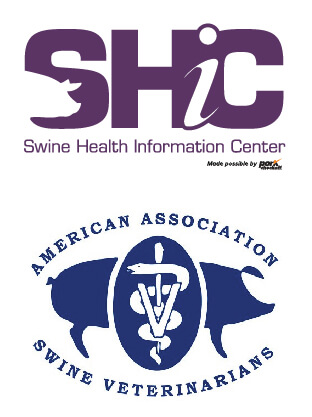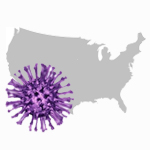
SHIC, launched by the National Pork Board in 2015 solely with Pork Checkoff funding, continues to focus efforts on prevention, preparedness, and response to novel and emerging swine disease for the benefit of US swine health. As a conduit of information and research, SHIC encourages sharing of its publications and research. Forward, reprint, and quote SHIC material freely. SHIC is funded by America’s pork producers to fulfill its mission to protect and enhance the health of the US swine herd. For more information, visit http://www.swinehealth.org or contact Dr. Sundberg at [email protected].


SHIC, along with FFAR and Pork Checkoff, joined together to fund a Wean-to-Harvest Biosecurity Program to be implemented over the next two years. Proposals to investigate cost-effective, innovative technologies, protocols, or ideas to implement biosecurity during the wean-to-harvest phase of production are now being sought. Proactively enhancing wean-to-harvest biosecurity will help control the next emerging disease in the US pork industry and improve US swine herd health, all part of SHIC’s mission including analysis of swine health data and targeted research to benefit the US pork industry.
Phase 1 of SHIC’s Wean-to-Harvest Biosecurity Program involved identifying subject matter experts and assembling task forces with the responsibility of establishing research priorities. Now in Phase 2, release of the request for proposals, the program continues to move forward with an ambitious timeline.
Priorities for the research proposals reflect input from key industry stakeholders recruited to join the SHIC Wean-to-Harvest Biosecurity Program Site Task Force and Transport Task Force. These experts come from allied industry, academia, veterinary practice, and organizations involved in pork production. Collectively, their experience and interest reflect contemporary issues related to wean-to-harvest biosecurity. Working at a rapid pace, each Task Force has met virtually several times to develop and refine priorities for the research proposals now requested.
“Task force members came together, working efficiently and effectively to identify priorities for wean-to-harvest biosecurity,” remarked SHIC Associate Director Megan Niederwerder. “SHIC appreciates the time and service of each task member to provide valuable insight on how to best fill this gap in pork production biosecurity.”
Research priorities focus on site and transportation biosecurity and cover three areas – bioexclusion for preventing disease introduction on the farm, biocontainment for preventing disease spread from the farm to reduce risk to neighboring facilities, and transportation biosecurity for preventing disease movement from markets and other first points of concentration back to the farm. “We are seeking novel tools across all three areas for a comprehensive biosecurity approach,” explained SHIC Executive Director Paul Sundberg.
With a pool of approximately $2.3 million available for the research, proposals are capped at $200,000 but individual proposals may be higher with sufficient justification for a project that will be unique, high impact, and have industry-wide benefit. The proposal template and instructions for completion and submission can be found at https://www.swinehealth.org/call-for-research/. The deadline for proposal submission is 5:00 PM CDT, December 16, 2022.
Site Biosecurity Research Priorities
The Site Task Force recommends an industry-wide assessment to define the current bioexclusion standards and protocols applied to prevent the predominant pathogen introduction routes in the wean-to-harvest phase. They envision the work including an estimate of degree of implementation nationally and regionally, to characterize the breadth and variation of currently implemented baseline practices.
In addition to this assessment, the Site Task Force identified four priorities:
Transportation Biosecurity Research Priorities
Diverse research proposals are encouraged and invited for submission and consideration for funding through this program. Decisions on awards funded and project initiation is anticipated to occur in early 2023.

The 2022 Japanese encephalitis virus (JEV) outbreak in Australia continues to be at the forefront of producers’ minds there and attract attention from around the world. As stakeholders in Australia assess what they know and what they are continuing to learn about the outbreak, international observers are addressing the potential for JEV to be discovered in currently naïve countries, bringing with it challenges to human and animal health. These topics, and others, were the focus of a recent symposium hosted by the Center for the Ecology of Infectious Disease at the University of Georgia, sponsored in part by the Swine Health Information Center. A total 156 people registered to attend the symposium (27 in-person and 129 virtual attendees) from Australia, Canada, France, Mexico, the Philippines, Singapore, and across the US. Of those, 30 were persons with USDA-affiliated agencies.
Providing the keynote address for the symposium, Mark Schipp, Australia’s Chief Veterinary Officer, shared three ways in which JEV may be identified – animals showing clinical signs, humans showing clinical symptoms, and mosquito surveillance. The diagnosis of JEV in pigs on the eastern side of Australia led to further diagnoses in people and mosquitoes. Data since January 2021 show 32 confirmed cases of JEV in humans with 10 additional probable cases. Only one of those humans had exposure to pigs, per Dr. Schipp. A novel strain of genotype IV of JEV has been sequenced consistently and found to be the causative source of the 2022 outbreak.
A total of 84 pork production premises were diagnosed with JEV in eastern Australia during 2022. Interestingly, there appears to be clear alignment with some geography in Australia, i.e., the Murray River.
Climatic events impacting the Murray-Darling River Basin were considered significant as well. After a long period of drought, intense rainfall with multiple flooding events occurred recently in the eastern side of Australia. Standing water created habitat for water birds and breeding sites for mosquitoes while attracting feral pigs as well. Water bird migration up and down the east coast of Australia is believed to be important for disease spread across large areas, whereas feral pigs and mosquitos are considered less mobile, but important factors for localized amplification and transmission of JEV.
Vaccines are not yet approved for use in the Australian pig industry. Trials are underway in Australia with a goal of local vaccine development and they are also evaluating the potential use of commercial vaccines from Japan. However, historical vaccines are based on protection against JEV genotype III and efficacy against genotype IV would require confirmation.
Dr. Schipp credited their work with wildlife organizations, including Wildlife Health Australia, as invaluable. Further, he emphasized a One Health collaboration as essential; in Australia, pre-existing data sharing arrangements with public health colleagues were vital to an effective response.
Australian Pork Producer Perspective
Drs. Kirsty Richards and Bernie Gleeson with SunPork, an Australian pork production company, reviewed their experiences and learnings as well during the symposium.
The initial indications of JEV on sow farms included delayed farrowing, reduced litter size, increased return to service, late term abortions, mummified, stillborn and shaking piglets. Case studies of four affected Sun Pork herds demonstrated up to a 9% decrease in pigs weaned.
Substantial production and financial costs have occurred due to JEV and an estimated 60% of Australia’s pork industry has been impacted, with a reduction of fresh pork supply from August-November this year.
There were parallel responses in the animal and human sectors with mosquito trapping and testing being conducted for surveillance early in the outbreak. Mosquito trapping varied significantly across SunPork farms, with 50,000 to 100,000 trapped at one location and just four at another.
Risk factors included standing water volume, water birds, and mosquitoes. The SunPork veterinarians said Australia is still working to identify how many bird species are competent hosts for JEV and the extent to which these interact with piggery operations. There is also uncertainty about the mosquito quantity that is needed to trigger an outbreak. Importantly, their experience showed that pig and semen movement was not a significant contributor to JEV spread.
Australian Surveillance Pivots to JEV
David Williams, lead, Diagnosis and Mammalian Infectious Disease Research Group, and colleagues at the Australian Centre for Disease Preparedness, Commonwealth Scientific and Industrial Research Organisation, were heavily involved in the laboratory diagnosis of JEV infections of animals throughout the 2022 outbreak.
In addition to human and domestic pig cases detected after the initial 2022 outbreak, active infections were detected in over 50 feral pigs in the Northern Territory of Australia. Several suspected horse cases as well as a single alpaca case were reported.
A One Health approach was undertaken to understand the molecular epidemiology of the Genotype IV outbreak strain of JEV, involving public and animal health laboratories from each of the affected Australian states. Whole genome sequences of JEV were contributed from infected domestic and feral pigs, humans and mosquitoes for phylogenetic analyses, which showed no clear geographic, temporal or host relationships between isolates. The data also supported pig movements as unlikely to have played a role in transmission.
Diagnostic testing at the Australia Centre for Disease Preparedness included the initial case confirmation from February 25, 2022, and resulted in genome characterization. Following the primary diagnosis, confirmatory testing and surveillance were launched.
ACDP used a PCR test they had recently implemented that enables detection of all five JEV genotypes. This update occurred approximately three years ago, a prescient event.
The potential mechanisms of JEV spread to Australia include water bird migration, microbats and fruit bats, wind dispersed mosquitoes and introduction of mosquitoes via aircraft or shipping. Environmental and ecological factors including the ongoing Pacific La Nina and subsequent flooding events provided opportunities for increased mosquito breeding and attracted large numbers of waterbirds to waterways.
Looking ahead, Dr. Williams says a continued and strengthened One Health approach is needed for surveillance and mitigation strategies. Expanded and enhanced surveillance may benefit from novel approaches including oral fluid testing for pen-based surveillance, effluent testing from piggeries, and consideration of other sentinel animal systems.
Other presentations during the JEV symposium addressed US JEV preparedness, including potential for importation and spread, federal strategy, one health point of view, as well as information on domestic hosts. These topics will be covered in future SHIC articles.
SHIC, launched by the National Pork Board in 2015 solely with Pork Checkoff funding, continues to focus efforts on prevention, preparedness, and response to novel and emerging swine disease for the benefit of US swine health. As a conduit of information and research, SHIC encourages sharing of its publications and research. Forward, reprint, and quote SHIC material freely. SHIC is funded by America’s pork producers to fulfill its mission to protect and enhance the health of the US swine herd. For more information, visit http://www.swinehealth.org or contact Dr. Paul Sundberg at [email protected].

Undiagnosed Respiratory Disease: How to Sample for Success and What’s New, a webinar presented by SHIC and AASV, included viewpoints of the practitioner, diagnostician, and pathologists all seeking answers to ongoing respiratory issues. Diagnoses of porcine astrovirus 4 and porcine hemagglutinating encephalomyelitis virus resulted from the pursuit of a diagnosis when more common viruses were ruled out. While unlimited resources for testing and diagnosis would be ideal for identifying root causes of respiratory issues not identified as common viruses, it is unrealistic per the participants in the webinar. However, knowing unresolved respiratory issues could be PAstV4 or porcine hemagglutinating encephalomyelitis virus expand the scope of diagnostic possibilities.
Dr. Evan Koep, Pipestone Veterinary Services, shared an overview of the challenge of endemic influenza on the farm, the system’s push for higher health, and desire to identify the cause of ongoing coughing. With a goal of eliminating influenza in sow herds within the Pipestone system, they hope to achieve a result of improved health and improved client satisfaction.
After two years, their influenza elimination program has a roughly 70% elimination success rate. Despite this success, some farms continue to have piglets coughing. This non-productive cough, at 20% to 60% prevalence, resembles influenza yet is confirmed not to be IAV via udder wipes, nasal swabs, and lung tissue testing.
Dr. Koep sought a definitive diagnosis, with tests for IAV, PPIV, PHEV, PRCV, MHR, and other bacteria requested. He also submitted fixed and fresh lung, trachea, heart, spleen, liver, kidney and tonsil tissues. While these tests were all PCR negative for viruses, histopathology said, “Lesions in the trachea and upper airways are suggestive of an epitheliotropic virus.”
From this point, next generation sequencing on lung samples with lesions was the next step with porcine astrovirus 4 found and confirmed by follow-up PCR on past cases. PAstV4, an uncommon virus, is not well known nor is its association with the respiratory tract.
Dr. Hause shared there are five genotypes of porcine astrovirus. Historically, they are associated with gastroenteric disease though in 2015, PAstV4 was detected in multiple respiratory samples submitted for metagenomic sequencing at the Kansas State VDL. Genome sequencing identified a novel AstV in the PAstV4 lineage in those cases.
Testing at KSVDL compared Ct values for positive samples between nasal and fecal material. There were significantly lower Ct values (higher levels of PAstV4 genetic material) in nasal swabs. It suggests positive tests are indicative of a respiratory tropism. Dr. Hause’s presentation summary revealed astrovirus infections are common in pigs and extraintestinal infection in pigs includes the respiratory system.
Dr. Derscheid reviewed trachea physiology. While a non-collapsible passageway for air, the trachea includes cartilage rings and mucosal lining, regulating both temperature and humidity. The trachea protects and cleans columnar epithelium, goblet cells, and mucociliary apparatus. Dr. Derschied shared typical respiratory tissue VDL submissions and provided guidance for sampling the trachea for study.
In presenting a case history, Dr. Derschied shared initial results of testing which indicated typical respiratory issues, including IAV. When the producer submitted additional tissues due to ongoing coughing, including notes on negative IAV, porcine parainfluenza virus 1, and porcine respiratory coronavirus results, further tests were initiated, including NGS, PCR, and in situ hybridization. These results indicated tracheitis with and without bronchitis, not just for PAstV4. Porcine hemagglutinating encephalomyelitis virus and Mycoplasma hyopneumoniae causing persistent cilia damage were other viruses identified.
Dr. Derscheid said, “We don’t see what we don’t look for,” and recommended examination of the trachea, submitting fixed trachea and/or leaving a portion attached to fresh lung. And, she emphasized communication.
In a retrospective evaluation of bronchitis and tracheitis of unknown etiology, Dr. Rahe began with a case observation. The clinical report was of coughing in three-week-old pigs with multifocal to coalescing atelectasis, all of which are classic findings for influenza. However, the case was influenza PCR negative. The diagnostic code was respiratory – bronchitis, viral – non-specified. PAstV4 was identified via NGS.
Dr. Rahe then addressed the question, “How many cases of non-specific tracheitis/bronchitis are caused by non-influenza viral infections?” The review did identify some cases of PAstV4 associated tracheitis/bronchitis. Those tend to be limited to the trachea and bronchi but do not seem to extend into bronchioles, perhaps due to a lack of receptors. Cts over 25 in these cases were negative via RNA scope.
SHIC and AASV present webinars on topics of industry interest. ISU Swine Medicine Education Center conducts the webinars; previous webinars can be accessed here: https://www.swinehealth.org/podcasts/

This summer, SHIC requested industry input about usefulness and enhancements to the Swine Health Information Center’s monthly domestic and global swine disease monitoring reports. Comments and responses to the SHIC survey highlight the broad value and diverse ways in which reports are utilized. Made available through the SHIC e-newsletter and website, the survey covered both SHIC’s domestic and global reports, including questions on value, actionable content, use of data, additional pathogens, and opportunities for improvement.
Responses were received from the US, across 10 states, and internationally, with most individuals being private practice veterinarians, academics, pork producers, and federal government employees.
Respondents widely agreed that both reports are valuable, with 100% (domestic) and 91.4% (global) of participants responding yes when asked if the monitoring reports provided valuable information. Examples of comments provided about what was most valuable in the domestic report included “reliable information on time,” “keeps me up to date on new threats,” “concise report to reference when talking to producers and decision makers regarding domestic disease,” and “graphs allow for comparison of my clients’ herds to the nation.” Similarly, the global report comments on value included “trusted source,” “important to understand the movement and changes in global health issues,” “useful as a teaching tool,” and “good indication on what disease pressures are around the world.”
In addition to value, participants were asked if the reports were used as a tool by providing actionable content which affects their day-to-day decision making. Most respondents agreed, with 75% (domestic) and 55.9% (global) of participants responding they do. Examples of comments provided about what kind of decision-making is affected by the domestic report included “budgeting and forecasting for the business,” “if PRRS is trending up in an area, we may do additional testing,” “vaccinate or not,” “notification of regional risks to clients,” “helps me fine tune biosecurity,” and “rethink opportunities for area contamination or elimination.” Likewise, the global report comments on decisions included “utilize examples from this report to communicate the biosecurity message to producers and decision makers,” “is our research focused in right direction for emerging risks,” “allows me time to make informed risk management decisions,” and “awareness of where ASF is from a travel standpoint.”
Beyond decision-making, respondents report using the domestic and global reports for educating stakeholders, staying up to date on diseases affecting production and exports, understanding disease trends regionally and status of national herd, knowing pathogen variants, advising clients and producers, personal education, research purposes, staying up to date on regulatory diseases and reviewing protocols. Additional pathogens suggested by respondents to include were Erysipelas, Streptococcus equi, PCV3, coccidia, Brachyspira sp., Lawsonia sp., Escherichia coli, sapovirus, and Salmonella sp.
Respondents were also asked to provide SHIC with suggestions on how to improve the value of the reports. Potential improvements to the domestic report included adding an interpretation section for quotes that media could utilize, adding information about treatments, inclusion of the economic impact of diseases, increasing regional representation of data, and keeping the report brief with bullet points. Potential improvements to the global report included adding the economic impact of diseases, keeping the report brief, including relevant vaccine information, and increasing report frequency. SHIC is currently exploring the feasibility for implementation of suggested improvements.

Since March 2018, SHIC’s Domestic Swine Disease Monitoring Report has been published monthly on its website and in its newsletter. Funded by SHIC and produced by the Swine Disease Reporting System team, the report provides real-time updates on megatrends of disease agent activity over time, age group, specimen, and states using data from five midwestern VDLs. During their October board meeting, the SHIC Board of Directors voted to continue funding the program for 2023.
In their renewal proposal, SDRS staff will maintain current aggregated PCR detection databases for PRRSV, PEDV, PDCoV, TGEV, IAV, PCV2, and MHP. IAV and PCV2 were added to the monitoring report in 2022. In response to a survey conducted by SHIC seeking input for improvements in the SDRS report, educational material with interpretation of reports and charts via short videos will be added in 2023. This digital multimedia content would be featured on the SDRS website and shared via link in reports provided to SHIC.
Interest in broadening the SDRS pathogen list was shared via the survey, as well as by the SHIC Monitoring and Analysis Working Group members considering the renewal proposal. Suggestions included E. coli, PCV3, Salmonella sp., and Brachyspira sp. with plans to add each in 2023 currently being considered. Another request from the SHIC survey and endorsed by Working Group members was incorporation of regional data analysis into the report, which currently represents collated data from all five VDLs.
The Domestic Disease Monitoring Report has evolved over time to incorporate data from VDLs at Iowa State University, University of Minnesota, and Kansas State University. It also includes the South Dakota Animal Disease Research & Diagnostic Laboratory and, most recently, the Ohio Animal Disease Diagnostic Laboratory. An Advisory Group of academicians, practitioners, producers, and diagnosticians review each monthly report and provides interpretation and context to the reporting and methodology.
Both SHIC and SDRS staff maintain focus on reports aligning with SHIC’s mission of protecting the health of the US swine herd. Reports share information on the activity of endemic and emerging pathogens affecting the US swine population, assisting veterinarians and producers in making informed decisions on disease prevention, detection, and management.
Rather than anecdotal field observations, this reporting tool provides robust diagnostic data, with statistical analyses and Advisory Group input, that enables early identification and response to emerging and re-emerging diseases in the US swine population. For example, data from the SDRS revealed higher infection rates of pigs post-weaning, a vulnerability that is now being addressed by SHIC’s Wean-to-Harvest Biosecurity Program, launched in June 2022.
In addition to publication on the SHIC website and in its newsletter, the SDRS report is available online at the ISU Field Epidemiology page. On this site, the SDRS team maintains a collection of daily updated online dashboards, links to their monthly podcast and YouTube videos, as well as the reports themselves.

This month’s Domestic Swine Disease Monitoring Report brings information about the increased activity of respiratory and systemic pathogens. PRRSV had a consecutive month with increased RT-PCR detection in the wean-to-market category. Mycoplasma hyopneumoniae and Influenza A virus had an overall increase in detection, in the case of Influenza, with a substantial increase in sow farms and grow-finish sites. Also, spikes in the number of confirmed tissue diagnoses of PRRSV, Influenza A virus, Streptococcus suis, Pasteurella multocida, and Glaesserella parasuis were observed. In addition, PEDV RT-PCR detection is still above the expected and had a moderate increase, particularly in the grow-finish sites. In the podcast, SDRS hosts talk with Dr. Andréia Gonçalves Arruda, assistant professor at Ohio State University, about spatial epidemiology applied to PRRSV regional control, herd repopulation, and the impact of multiple PRRSV strains in production systems.

Reach about the spread of African swine fever in the Philippines in this months Global Swine Disease Monitoring Report. Western Visayas in the Philippines had previously been among the last few regions in the country remaining ASF-free since the first outbreak in July 2019. The report also details disease surveillance at several points of entry. Pork products were seized in Taiwan. In the Philippines, the ASF task force seized over 1,400 lbs of pork products from regions with confirmed ASF cases in Negros Occidental. Thailand authorities intercept smuggling of pork in air passenger luggage in Bangkok by the Customs Department at the airport. And in the UK, concerns are rising as over a single weekend of inspections, 2.5 tonnes of illegal pork products from ASF-affected countries were seized at the port of Dover.
Copyright 2024 | Swinehealth.org | Website by Heartland Marketing Group